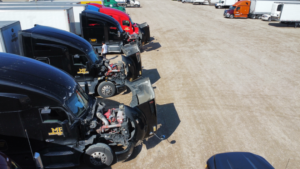Have you ever found yourself sweating bullets as you try to squeeze your big V8 long bed truck into a tiny parking spot? Well, you’re not alone! Parking these giant machines in cramped city spots is no small feat. Whether you’re a seasoned truck driver or a newbie just starting out, getting it right can often feel like solving a tricky puzzle.
In this guide, “How to Parallel Park a V8 Long Bed Truck: Challenges and Solutions,” we’re diving straight into the nitty-gritty of truck parking. From the stubborn challenges that come with handling such a hefty vehicle to practical solutions that make the task a breeze, we’ve got you covered. We understand the unique needs of truck drivers in India and have tailored tips to help you maneuver your truck smoothly and confidently into any space, no matter how intimidating it might seem.
By the end of this article, not only will parking in tight spots seem less daunting, but you’ll also feel more confident behind the wheel of your V8 long-bed truck. Let’s roll up our sleeves and tackle truck parking head-on, turning those parking woes into a skill you can be proud of!
Challenges in Parallel Parking a V8 Long Bed Truck
If you’ve ever tried to park a V8 long bed truck, you know it’s like trying to thread a needle with a rope! These trucks are big and powerful, and fitting them into a parking spot can sometimes feel more like a battle than a simple task. Let’s break down why parking these beasts can be such a tough cookie to crack.
First off, the sheer size of a V8 long-bed truck is the biggest hurdle. These trucks are longer than your average vehicle, which means you need a lot more space to get them parked. Imagine parking a giant in a space that seems cut out for a little sprite; that’s the kind of challenge we’re talking about here!
Visibility, or the lack of it, is another major challenge. Sitting high up in the cab of a truck, you might feel like the king of the road, but when it comes to spotting those tight lines on either side of a parking spot, it’s not so royal. The truck’s long body blocks your view, making it hard to see how much room you have left at the back and sides.
Maneuverability is yet another test. These trucks aren’t exactly known for their grace in tight spots. The turning radius on a V8 long-bed truck can make a simple parking move feel like a complex dance routine. You must be precise with your steering to avoid hopping the curb or, worse, nicking other parked cars.
But worry not! While these challenges might seem daunting, they’re not insurmountable. With the right techniques and practice, you can master the art of parallel parking your V8 long-bed truck, no matter how intimidating the space. So, buckle up, and let’s get ready to tackle these truck parking puzzles head-on!
Related: Atomic Truck Parking Solutions: Affordable and Safe Options for All Truck Types
Step-by-Step Guide to Parallel Parking a V8 Long Bed Truck
Preparation
Before you even start the engine, make sure you’re all set for success. First, adjust your mirrors to ensure you have a clear view of the space and your surroundings, this includes both side mirrors and your rear-view mirror. It’s also a good idea to remove any items that might block your view out the back window. Check the length of the parking space to be sure it can comfortably fit your V8 long bed truck, with a bit extra for maneuvering. If you’re new to driving this size of a vehicle, keep a note of the truck’s dimensions handy on your dashboard. This preparation step is crucial because knowing your vehicle’s size and how much room you have to work with makes the rest of the parking process smoother and safer.
Approaching the Space
As you approach the parking space, slow down and signal early to alert other drivers of your intent to park. Keep your truck parallel to the parking line as you approach, about two feet away from the vehicles parked next to the open spot. This distance gives you enough room to maneuver but is close enough to not disrupt the flow of traffic. Keep your pace steady and use your mirrors to continuously check the distances around you. It’s important to approach slowly and give yourself time to react to any pedestrians, cyclists, or other obstacles that might be in your blind spots.
Maneuvering Into the Space
Now, the real test begins. With your truck aligned next to the space, shift into reverse. Begin to back up slowly, turning your steering wheel towards the curb when the back end of your truck is level with the rear bumper of the car in front of the parking space. Continue to reverse in a smooth, controlled arc, keeping an eye on your mirrors to monitor your distance from the curb and the vehicle behind you. If you start to angle too close to the curb or another vehicle, pause, pull forward slightly, and adjust your angle before continuing. This step may take a few adjustments to get your truck neatly between the lines, so patience is key.
Correcting Position
Once you’re mostly in space, it might not be perfect yet—that’s okay! If your truck isn’t parallel, you’ll need to straighten up. Pull forward just enough to give you space to adjust without hitting the car in front, then back up again slowly, tweaking your steering to straighten your truck in the space. This might take a few back-and-forth adjustments. The goal is to have your truck parallel to the curb and evenly spaced between the cars in front and behind. Make sure you leave enough space to pull out easily when you leave. Finally, once you’re satisfied with the positioning, set your parking brake, turn off the engine, and give yourself a pat on the back for a job well done!
Final Adjustments
Now you’ve positioned your V8 long-bed truck nicely in the parking slot, it’s time for the final touch-ups to ensure everything is just right. Start by taking a final look through all your mirrors to double-check the spacing. Your truck should be parallel to the curb with enough room for other vehicles to pass safely without squeezing through.
Next, check how close you are to the curb. Ideally, your truck’s wheels should be about six to twelve inches away from the curb. If you’re too close or too far, you might have to readjust by pulling forward slightly and then backing up again to fine-tune your position. This step is crucial to avoid any tickets for improper parking and to make sure you’re not obstructing traffic flow.
Once you’re satisfied with the truck’s distance from the curb, look around one last time for any pedestrians or obstacles before turning off your engine. It’s always good practice to be aware of your surroundings, especially in busy areas. Lastly, ensure your truck is securely parked by engaging the handbrake, especially if you’re on a slope. This prevents the truck from rolling and keeps both your vehicle and nearby pedestrians safe.
With these final adjustments, you can step out of your truck knowing you’ve successfully and safely parked your V8 long bed truck in a tight spot. Now you can head on with your day with one less worry!
Related: Trailer Storage Near Me: How to Find Secure and Cost-Effective Options Nearby
Tips for Easier Truck Parking
Know Your Truck
Before you even attempt to park, you need to know your truck like the back of your hand. Understand its size, turning radius, and blind spots. This might sound simple, but knowing your vehicle’s dimensions and how much space it needs can save you from a lot of guesswork and tight squeezes. Take a moment to adjust all your mirrors for the best possible view, and consider investing in additional blind spot mirrors if necessary.
Choose the Right Spot
Not all parking spots are created equal, especially when it comes to big trucks. Look for a space that’s a bit longer than your truck to give yourself some extra room to maneuver. Avoid parking in spots that are too tight or have obstacles on either side. If you’re new to truck parking, practice in quieter, less crowded areas to build up your confidence.
Use Technology
If your truck comes equipped with parking sensors or a rear-view camera, make full use of these tools. They can make a world of difference in guiding you smoothly into the parking spot. These technologies are designed to help you gauge distance and offer a better perspective of the parking space, something particularly useful for large trucks.
Practice Patience and Precision
Parking a big truck isn’t something you rush. Take your time to line up your approach, and don’t be afraid to adjust and realign if you’re not getting it right the first try. Sometimes, you may need to pull out of the space and start over. It’s better to take a few extra minutes to park safely than to rush and risk an accident.
Stay Calm and Carry On
Finally, stay calm. If you feel pressured by other drivers waiting for you to park, just remember that safety comes first. Keeping a cool head will help you focus on the task at hand and prevent any costly mistakes.
Related: Ultimate Guide to DFW Truck Parking: Top Spots, Costs, and Convenience
Conclusion
So there you have it! Parking a V8 long-bed truck doesn’t have to be a daunting task filled with sweat and worry. With the right approach and a bit of practice, you can handle it like a pro. We’ve walked through the challenges, given you a step-by-step guide, and offered practical tips to make truck parking simpler and safer.
Remember, the key to success in parking these big trucks is preparation and patience. Take the time to get to know your vehicle’s size and capabilities, choose your parking spots wisely, and use technology to your advantage. Don’t rush the process; instead, take it slow and adjust as needed. Every attempt is a learning experience, helping you become more adept for the next time.
Whether you’re a seasoned truck driver or just starting, these tips from Dallas Truck Parking will help you navigate even the tightest of spaces with confidence. Keep practicing, stay calm, and soon, parallel parking your V8 long-bed truck will feel like second nature. Safe driving and happy parking!






